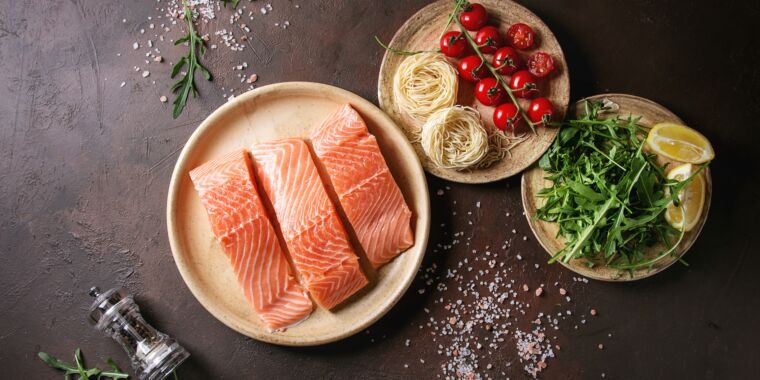
The U.S. Food and Drug Administration on Wednesday proposed a long-awaited overhaul of the definition of the term “healthy” on food packaging, ultimately eliminating the mind-boggling 1990s criteria that made healthy foods like nuts, salmon, avocados, olives, oil, and even water. does not qualify for the label.
The new definition is not immune to criticism, and Americans will likely still face uncertainty about healthy food choices as they meander down the aisles of supermarkets. But the proposed update — coinciding with this week’s White House conference on hunger, nutrition and health and a national strategy to improve American nutrition and reduce hunger — is a marked improvement.
Under current criteria, established in 1994, the FDA allows food manufacturers to label their products “healthy” based on myopic maxima and minima of specific nutrients. That means “healthy” foods have universal maxima for saturated fat, total fat, cholesterol and sodium, and must also provide a minimum of 10 percent of the daily value for one or more of the following nutrients: vitamin A, vitamin C, calcium, iron , protein and fiber.
Under this rule, foods with a lot of added sugar — such as low-fat yogurt or sugary kids’ breakfast cereals — qualify for a “healthy” label because they meet the other qualifiers. The same goes for some nutritionally questionable white breads. Still, whole foods like avocados or currently recommended meats like salmon don’t qualify because of their fat content, which conflicts with the current science-based health benefits of plant foods. And even plain water or plain carbonated water can’t be labeled “healthy.”
New rule
The absurdity of this definition made headlines in 2015 when the FDA sent a warning letter to the maker of Kind bars saying it couldn’t use the term “healthy” on its nut-based bars because they contain too much saturated fat. Only nuts and seeds generally do not qualify for the ‘healthy’ label under the current rule. The company pushed back, and in 2016 the FDA reversed course and said it plans to update the definition — which brings us to the proposed update this week.
Under the rule proposed by the FDA — which could still change — the agency now takes a more holistic approach to evaluating foods, saying that foods can be labeled healthy if they:
- Contains a certain meaningful amount of food from at least one of the food groups or subgroups (e.g. fruits, vegetables, dairy, etc.) recommended by the dietary guidelines.
- Stick to specific limits for certain nutrients, such as saturated fat, sodium, and added sugars.
Importantly, for this last point, the nutrient limit thresholds would vary based on the type of food or food group a product contains, ie an olive oil-based product has a higher limit for saturated fat than vegetable products, which have a lower limit for added sugars than grain-based foods. The FDA provided a handy table here on the suggested limits for different food groups.
The FDA also provided a sample for a grain that would meet the new “healthy” definition: It should contain “¾ ounces of whole grains and no more than 1 gram of saturated fat, 230 milligrams of sodium and 2.5 grams of added sugars.”
The FDA hopes the change will help consumers select better supermarket foods and encourage food manufacturers to adapt their products to the new definition.
The review is “an important step toward achieving a number of nutrition-related priorities, including providing information to consumers to choose healthier diets and adopt healthy eating habits early,” FDA Commissioner Robert Califf said in a statement. . “It can also result in a healthier food supply.”
Need change
Such nutrition-related goals are more important than ever. On Tuesday, the Centers for Disease Control and Prevention reported data showing that the number of states with high rates of adult obesity — defined as 35 percent of adults or more — has more than doubled since 2018. Nineteen states and two territories now have high rates. Childhood obesity has also risen during the pandemic. According to a study published last year in the Journal of the American Medical Association, the percentage of 5- to 11-year-olds who are “overweight” or “obese” rose from 36.2 percent in the year before the pandemic hit to 45.7 percent by January 2021.
Obesity at any age can lead people to serious health problems, such as high blood pressure, sleep apnea, heart disease, stroke, type 2 diabetes, some cancers, serious consequences of COVID-19 and poor mental health. The top three causes of death in 2020 were heart disease, cancer and COVID-19.
Of course, obesity is a complex, multifactorial health condition, and diet is just one part of it. But there’s plenty of data to indicate that people in the US don’t eat well — and the typical American diet fuels chronic health problems. The FDA notes that 75 percent of Americans have a diet low in fruits, vegetables, and dairy; 77 percent consume too much saturated fat; 63 percent eat too much added sugar; and as much as 90 percent exceed the limit for sodium.
The FDA’s new proposed definition for “healthy” certainly won’t solve those problems overnight. Some health advocates and experts say it may have minimal effects, and the package labeling warns of: unhealthy content — with things like red light symbols — may be more effective than labeling “healthy” foods. But the update is a marked improvement on the current definition of “healthy,” which is not aligned with evidence-based dietary recommendations.
Commenting on The Washington Post, Kind CEO Russell Stokes said the company is celebrating the proposed update. “A rule that reflects current nutritional science and dietary guidelines for Americans is a public health victory — and that is a victory for all of us.”

